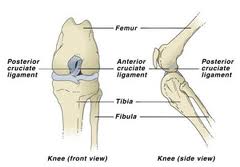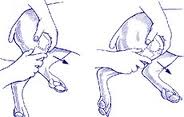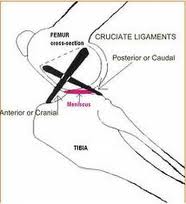Cruciate ligament injury is an extremely common orthopedic condition in our canine patients, both large and small. It can be expensive to treat surgically with no assurance of a perfect outcome.
The cruciate ligament is a strong band that connects the femur (upper thigh bone) to the tibia below. There are actually two cruciate ligaments, one termed cranial and the other, caudal. Both are vital structures to knee stability. They get their name from “crucifix” because they cross inside the joint. The cranial cruciate ligament (CCL) which prevents the tibia from moving forward in relation to the femur, is most commonly damaged in our canine patients.
 When this ligament breaks, the stifle (knee) becomes not only painful but unstable. Over time, the instability leads to the development of arthritis. There is no doubt that the joint needs to be restabilized, but what is the best way to accomplish this? There are a myriad of surgical procedures available and much debate surrounding the superiority of one technique over another.
When this ligament breaks, the stifle (knee) becomes not only painful but unstable. Over time, the instability leads to the development of arthritis. There is no doubt that the joint needs to be restabilized, but what is the best way to accomplish this? There are a myriad of surgical procedures available and much debate surrounding the superiority of one technique over another.
Because it is a soft tissue injury, veterinarians make the diagnosis of a damaged ligament by palpating the patient’s knee (stifle) for instability. In a normal stifle, the tibia should not slide forward relative to the femur when the femur is held in place. If it does, the excess motion is termed a drawer sign which means the ligament is broken or stretched.
 A second manipulation, called a tibial thrust, involves flexing the hock while checking the tibia for forward movement. A positive tibial thrust also confirms the presence of cruciate damage.
A second manipulation, called a tibial thrust, involves flexing the hock while checking the tibia for forward movement. A positive tibial thrust also confirms the presence of cruciate damage.
We use a combination of the cranial drawer slide and tibial thrust tests to make the diagnosis of a ruptured cranial cruciate ligament (CCL). In most cases, our patients are awake when we manipulate the joint. In rare cases, we need them more relaxed (with sedation or anesthesia) to properly evaluate the stifle for instability. We sometimes take radiographs to assess the joint for complicating arthritis.
Rupture of the cranial cruciate ligament occurs most frequently in middle-aged dogs but in recent years, more younger dogs are developing the condition. Rottweilers, even those under four years of age, are particularly prone to injury because of inherent degenerative changes in their ligaments. Obese dogs with sedentary habits are also at an increased risk.
 Because the breaking strength of a cruciate ligament is roughly four times the weight of the dog, it is unlikely that a healthy ligament will break unless it’s under incredible strain.
Because the breaking strength of a cruciate ligament is roughly four times the weight of the dog, it is unlikely that a healthy ligament will break unless it’s under incredible strain.
Researchers have found that many dogs over five years old have some degeneration of their CCL. In more than 80 percent of ruptures, there is pre-existing damage. This ligament deterioration has been tied to conformational abnormalities such as patellar luxation, bowlegs, straight stifles and hocks, as well as the presence of immune-mediated arthritis. Degeneration over time progressively weakens the ligament, predisposing it to stretching and breaking.
In other cases of CCL rupture, meniscal damage occurs. The bones can move so far out of place during the rupture event that the menisci (the cartilage plates that form a cushion between the femur and tibia) are torn or folded.
The pain of an acute CCL rupture is often so severe that the dog refuses to use the leg. If only part of the ligament tears, or if it stretches, the lameness is much milder and the chronic discomfort can be missed for a long time.
CCL damage is traditionally treated either medically or surgically depending on the weight of the dog and the degree of instability. Eighty-five percent of dogs under 15 kilograms, given rest only, become clinically normal within six months or improve sufficiently to allow adequate function. In contrast, a mere 20 percent of dogs over 15 kilograms improve with rest alone.
Given time, the joint capsule thickens and forms fibrous tissue. In small dogs, this is sufficient to stabilize the joint. Different methods have been used to speed or augment this process. Rest, particularly no jumping or twisting, helps lessen strain and stretching of the joint. CartrophenR injections reduce inflammation and speed healing.
For larger dogs, surgery has traditionally been the preferred option for optimal long-term function. Surgery stabilizes the joint, speeds the rate of recovery, and minimizes degenerative changes in the stifle.
Surgical options for CCL rupture abound, but most repairs belong to one of two groups – they either implant a false “ligament” that mimics the action of the ruptured CCL, or they change the anatomy of the stifle joint to prevent the constant strain on the stifle joint.
In all techniques, the stifle joint is opened and inspected so that the CCL rupture can be confirmed and the menisci checked for injury. Damaged menisci are removed to eliminate pain. The joint functions well without them. If a damaged meniscus is not discovered and treated, it will continue to cause discomfort and inhibit mobility.
The torn ligament cannot be repaired by simply suturing the ends together. The severed ends retract into the joint and are impossible to suture. Instead, the remnants are removed and a prosthesis is sewn into place to mimic the action of the CCL – in other words, to stop the tibia from sliding forward during weight bearing. In an intra-articular (inside the joint) technique, a strip of the patellar tendon (or other material) is passed through the joint, exits on the back side, and is anchored in place.
In extra-articular (outside the joint) repairs, a strong implant such as nylon is placed on the outside surface of the knee, connecting the femur to the tibia. It again mimics the CCL function and stabilizes the joint. A fibrous band eventually forms on the surface of the suture, adding strength to the repair.
Surgical success is measured by how well the lameness resolves post-operatively. In one study involving an extra-articular repair, lameness more than two months after the surgery was seen in 23-30 percent of large breed dogs and 7-11 percent of small breed dogs.
The latest surgical technique to be used for cruciate ligament rupture is the tibial plateau levelling osteotomy (TPLO). In this technique, the joint’s anatomy is altered. Instead of replacing the function of the cruciate ligament with an implant, a TPLO changes the forces in the joint that originally caused the CCL to rupture.
In a TPLO, the top of the tibia is cut and rotated to change the angle of the plateau. After the surgery, when weight is put on the leg, the tibia tends to slide backwards so it does not need the CCL for stability.
The TPLO is relatively new, but its merits have been closely scrutinized. Studies now show no real advantage over conventional repairs if both are done by a competent surgeon. A TPLO costs roughly twice what an extra-articular repair costs.
Surgery, no matter what type, does not inhibit arthritis development. The majority of dogs that undergo surgery go on to suffer from arthritis.
Most importantly, many dogs also go on to rupture the cruciate ligament in the second knee. Some studies suggest an incidence as high as 75 percent in large breed dogs. The second break occurs due to the weight shift to the “healthy” knee while the first knee is recovering.
FSLLL Laser – An alternative management technique for cruciate ligament rupture in dogs
Our experience, and that of other veterinarians using frequency-specific, low level laser therapy, is that 60-80% of dogs with cruciate ligament rupture can heal (stabilize over time) without surgery. In a study done by one veterinarian, 62 of 63 dogs recovered with VNA (veterinary neuronal adjustment) and FSLLL (frequency-specific low level laser) therapy. At a university in the States, researchers are currently studying the effectiveness of this form of laser therapy in CCL ruptures as an alternative to surgical repair.
FSLLL therapy provides a “viable chance to avoid an expensive surgery”. Surgery is always an option. It can be done immediately, and in some cases, especially those dogs with cruciate damage combined with meniscal tears, surgery should be performed as soon as possible.
The alternative is to play the odds and start laser and VNA treatment immediately. If it is going to work well, the result is evident within six weeks. Surgery can always be done later if the patient is one of the few that does not respond favourably to this approach.
There are three reasons why FSLLL therapy can fail: overuse (the dog feels too good too soon); the presence of another dog in the family (plays too much or too hard); and pre-existing meniscal damage. In the case of a “crunchy” knee from meniscal injury, surgical stabilization is highly recommended.
Even if surgery is the best option for the initial stabilization of a stifle, there are two reasons to do VNA and laser therapy. First, recovery will be much faster when this treatment is added to the regime. More importantly, these therapies can significantly reduce the incidence of CCL injury in the other stifle. We also give injections of Cartrophen-Vet to help decrease joint inflammation and reduce arthritis.
During laser therapy, the dog needs to be restricted in activity for 3-7 weeks (no excessive exercise or play) to promote stabilization of the joint. This can be challenging because most patients feel so good! With a normal recovery, it usually takes four months before a dog can return to pre-injury levels of physical activity.
Dr. Louise Janes D.V.M. & Dr. Jeff Grognet D.V.M.
 Mid-Isle Veterinary Hospital
Mid-Isle Veterinary Hospital
5-161 Fern Road West
Qualicum Beach, BC
Tel (250) 752-8969
See all articles by Dr. Louise Janes D.V.M. & Dr. Jeff Grognet D.V.M.




Good morning I have a female staffy/boxer 7 years old weighing 29kg that tore her cruciate ligament on Dec 17th. We are going towards the CONSERVATIVE MANAGEMENT process. Our vet has offered strongly for the TPLO but we do not like the idea of this surgery.Our opinion it is a horrible surgery. We could chose the EXTRACAPSULAR surgery but since the past few days Nellie is bearing more weight on the affected leg and we are wondering if we keep up with the low activity she could recover well. I found the site DOG ACL INJURY-IS SURGERY REALLY NEEDED. Nothing is for certain, surgery or CM but I was wondering what your thoughts were on this. Thank you Liannora
The conservative approach can work in some dogs. It is best to discuss this with your veterinarian. The other option is to find a veterinarian that is used to this type of management of ruptured cruciate ligaments.
Pretty sure I just read a few people who opted NOT for surgery, instead restricted mobility (2 months with short walks no running or jumping),custom fitted brace that can be removed once the dog is healed, ice and heat flexing exercise, supplement to avoid/or help with possible arthritis. SO tomorrow I take my 85 lb doodle back to vet for xrays and diagnosis. After all, I want what’s best for her as long as she isn’t in pain and can live a normal life, without a limp or surgery.
Yes, managing them medically can be an option. Here’s a link to our website that explains this process.
Dr. Jeff Grognet
My dog had surgery on her rear left knee on May 5th (48 hours out now). They found a pratial tear in one of the two strands of the anterior cruciate ligament. They removed the ligament entirely and ran a suture on the outside of the joint. She is doing well but we have a lot of physical therapy to get her back to being a normal dog. I use a lot of natural products to help with the arthritis: Zyflamend by New Chapter, Astaxanthin, Glyco-Flex III chews, Cod Liver Oil Vet Best Hip+J
Hi, just wanted to say how helpful this article is, thank you!